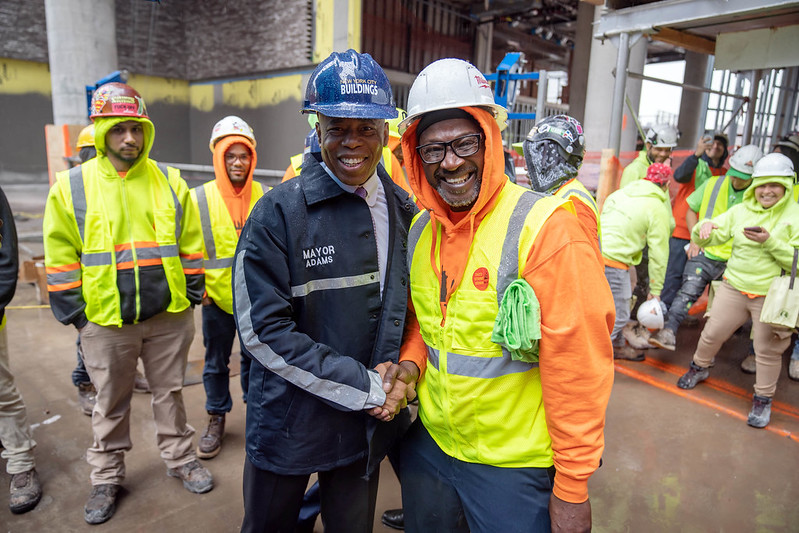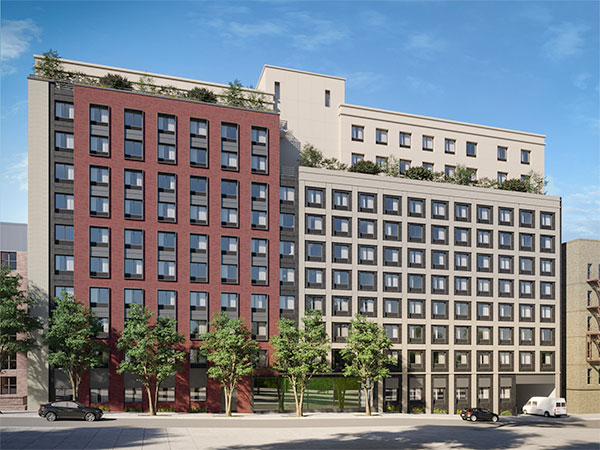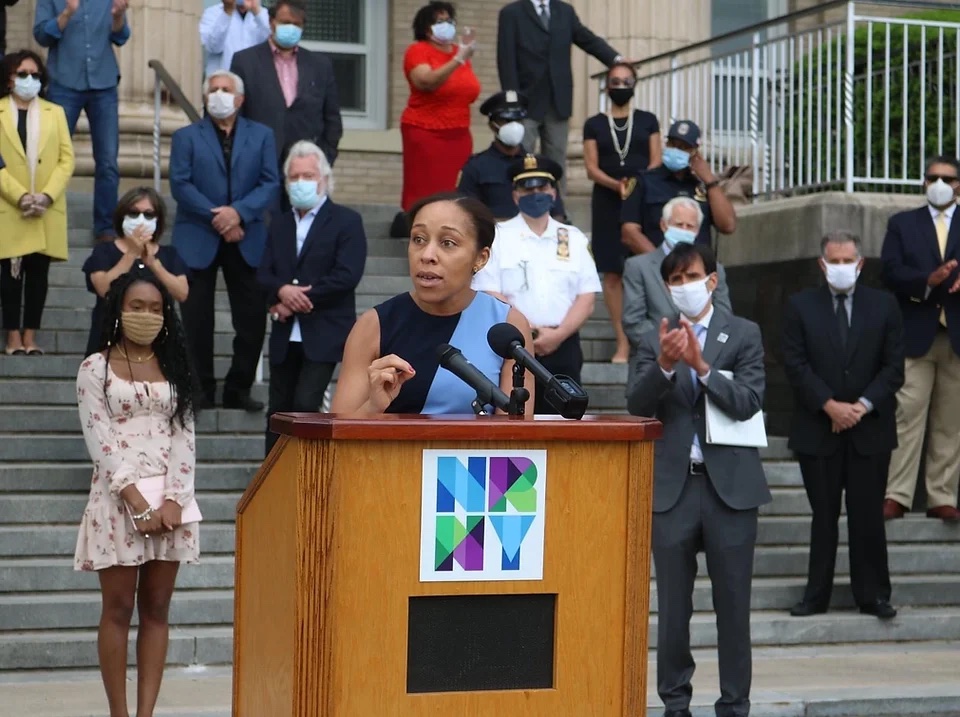Mayor Adams’ Plan For Housing and Good Jobs Is The Right One

Mayor Adams talks housing (photo: Mayor's Office)
Mayor Eric Adams has set the right tone and vision for rebuilding New York City’s middle class, and the Working People’s Agenda he outlined in his State of the City address should be welcomed by all New Yorkers.
A recent Moody’s Analytics study rated New York City #1 among the most rent-burdened cities in the nation. It’s an honor none of us want. That report also said that a New Yorker needs to earn at least $177,000 annually to not be “rent burdened,” as defined by the federal government. Moody’s found that many New Yorkers need to spend an astounding 69% of their income on rent.
As Mayor Adams indicated, making New York City more affordable and accessible hinges on the construction of 500,000 more homes across all five boroughs over the next decade. He has committed $23 billion for housing, including money for repairs to NYCHA buildings. As he stated clearly:
1) “You need good jobs and pathways to get those jobs, and those jobs need to be able to support a home for you and a family,” and
2) “New York must remain a place where working people can get a foothold and afford an apartment while simultaneously raising a family in a community.”
These issues are hardly new. As far back as 1997, the New York City Council was documenting the city’s declining middle class in its report Hollow In The Middle: The Rise and Fall of NYC’s Middle Class. But with renewed leadership and vision in City Hall, we have an opportunity to finally turn these trends around.
We can accomplish these goals, in addition to the mayor’s call for increased MWBE contracting goals and connecting New Yorkers to apprenticeship programs.
First, the only way to create good jobs in construction is by hiring union contractors to meet the city’s housing needs with the 100,000 diverse workforce members they employ. Here is what the Building Trade Employers Association’s (BTEA) union construction industry looks like today:
1) More successful MWBE contractors than any other in New York, with 42% having revenues of $5 million or more and 21% having revenue of $1-5 million.
2) Over 50% of the 100,000 members of the building trade union employed by BTEA contractors are people of color — 30.5% Latino and 21.2% Black, as well as 3% women.
The New York City Economic Development Corporation’s January 2023 economic snapshot report showed there are significant disparities within the labor market in unemployment with the Black unemployment rate at 11%, which is 4 times the rate of white unemployment at 2.8%.
A 2021 study conducted by Urbanomics for the BTEA shows that Black union construction workers earn 36.1% more in wages than Black non-union construction workers. And Latino union construction workers earn 52.7% more in wages than non-union Latino workers.
The BTEA recommends the following:
- Quickly implement the Mayor’s recommendations from his Get Stuff Built report.
- Commit to building quality housing with BTEA contractors and building trade union labor.
- Reduce the cost of construction by eliminating unnecessary hurdles and red tape, like the state’s outdated Scaffolding Law that places exorbitant insurance premiums on builders, especially women and minority contractors.
- Adopt the recommendations of the Mayor’s Capital Process Reform Task Force for public works contracts.
Many of these recommendations will require state legislation and New York City needs the governor and the Legislature to work in partnership to turn these recommendations into reality. Sitting in the same room working toward a common goal, developers, contractors, building trade unions, and community leaders can achieve the mayor’s goals and make New York City affordable and livable again for families.
Let’s rebuild the middle class base that has long been the backbone of this city and make sure the slow hollowing out that has taken place over the last quarter-century is no more.
***
Louis J. Coletti is president and CEO of the Building Trades Employers’ Association (BTEA).
***
Have an op-ed idea or submission for Gotham Gazette? Email This email address is being protected from spambots. You need JavaScript enabled to view it.
The City Council Should Reject Misguided Housing Bill

Affordable housing in the Bronx (photo: @NYCHousing)
A new consensus is taking shape in New York City: politicians, advocates, and policymakers are prioritizing ways for the city to produce more housing. Of course, there are still plenty of housing disagreements, but most now agree that New York’s severe affordability crisis is caused by the fact that there is not enough housing to go around.
While this is progress, New York City still has plenty of work to do if Thursday’s City Council Housing and Buildings Committee hearing is any indication.
City Council Members will hear feedback on a series of misguided bills highlighted by Intro 0637, which would require New York City to “prioritize not-for-profit developers and community land trusts” whenever it “disposes of land for affordable housing.” While that may sound innocuous, it would impose new bureaucracies and inefficiencies in housing production. It is the exact type of housing policy that got us into this crisis in the first place – and one that should be roundly rejected.
First, it is important to consider the overall context in which New York is making policy. The Mayor’s Management Report showed that New York City produced 45% fewer affordable homes in 2022 than it did the year prior. Despite the city’s new language about housing production, these figures are a stark reminder that rhetoric alone will not ensure our neighbors are safely housed.
The drop comes as the need continues to grow: a recent study found that New York City needs to add an additional nearly 600,000 units just to account for the lack of production over the last decade. And with the darkest days of the pandemic now years behind us, people are flocking (back) to New York City – causing intense competition for the housing stock we do have as the economy rebounds, many workers return to the office, and others want to live in the city as they work from home.
To make a dent in this crisis, New York City needs to utilize every tool at its disposal. It makes very little sense for a policymaker to reject material help from an entity solely due to its tax status – a framework the city does not use when purchasing city vehicles or any other type of good. In fact, doing so would functionally amount to trying to solve a problem that requires two hands with one hand tied behind our back.
Worse, Intro 0637 would kneecap the affordable housing industry’s growing MWBE presence. If passed in its current form, the bill would disenfranchise businesses owned by people of color and women. Right now, roughly 80% of all projects created by members of The New York Real Estate Chamber – a BIPOC-focused chamber of commerce – are affordable housing projects done in partnership with city agencies, including affordable and supportive properties like the Alabama Avenue Apartments in Queens, The Grand in the South Bronx, and Balton Commons in Harlem.
Affordable housing production is one of few bright spots for MWBEs in New York City, as nearly 84% of MWBEs “do not have access to city spending” right now and just 3.8% of city contracts flow to MWBEs. By prioritizing non-profits on City-owned land, we risk perpetuating these figures for no reason other than to satisfy pre-existing ideological preferences.
That last point is particularly instructive: there is no reason for this so-called “fix.” Because of the way affordable housing is created, all City-owned land goes through a request-for-proposals (RFP) process that guarantees permanent affordability regardless of a developer’s tax status, so the change would have zero bearing on the rents residents would pay, even decades from now.
Additionally, for-profit developers are already prohibited from bidding on such RFPs unless there is at least 25% ownership in a project by either a not-for-profit or MWBE. In other words, Intro 0637 would slow housing production by limiting choice and further closing off MWBE firms from city coffers to solve a problem that does not exist.
New Yorkers deserve housing policy conversations that will meaningfully address the housing shortage that is causing rents to balloon for everyone. What they will get on Thursday is a distraction from those core issues – and a return to a time when New York City’s leaders were far less serious about making the City as affordable as it can be.
***
Jolie Milstein is president and CEO of the New York State Association for Affordable Housing. On Twitter @NYSAFAH.
***
Have an op-ed idea or submission for Gotham Gazette? Email This email address is being protected from spambots. You need JavaScript enabled to view it.
New York Latino Politics Beyond New York City

Yadira Ramos-Herbert (photo via campaign website)
On Thursday February 16, the New Rochelle City Democratic Committee made history by endorsing the mayoral candidacy of Yadira Ramos-Herbert in this year’s election. An Afro-Latina of Puerto Rican and Dominican descent and currently a City Council member, Ramos-Herbert is the first person of color to receive a major party’s endorsement for mayor in New York’s seventh largest city. Ramos-Herbert’s candidacy and the committee’s endorsement helpfully remind us that Latino politics in New York is about more than New York City; the Latino presence has been and continues to be felt throughout the Empire State.
Truth be told, my columns for Gotham Gazette have focused exclusively on the Latino political reality in New York City or at the statewide level. That’s for one key reason: because the overwhelming majority of the Latino population in New York resides in New York City — about 67%. Most Latino elected officials in New York represent parts of Gotham as well. Yet, that focus of mine (and sometimes others’) overlooks a good portion of our peoples’ political realities in other parts of the state — realities that point to growing Latino communities and their significant political achievements. It is high time I correct that oversight.
The achievements of Latinos in New Rochelle are one such example. In many ways, New Rochelle has been a city of firsts in New York. It is there where the first Mexican-born candidate was elected in New York — Roberto Lopez, elected to New Rochelle’s City Council in 2007. Along with Ramos-Herbert, the current New Rochelle City Council also includes Latina Martha Lopez.
The Latino population in New Rochelle has increased rapidly over the last few decades and Latinos now comprise a third of the population in that city. Most of those Latinos are of Mexican descent. The rise of Latinos in the overall population has also resulted in an increase in the number of Latino registered voters, who have now surpassed African Americans as the largest non-white ethnic group among registered voters, forming 20% of the overall electorate. Surely Ramos-Herbert as the mayoral pick for the New Rochelle Democratic Party reflects that the future of the city is Latino.
Yet New Rochelle is not the only city in Westchester County with a growing Latino population. The city of Yonkers, the county’s most populous, has the largest number of Latinos, according to census data, with 89,605 Latinos, a whopping 42% of its entire population. However, when it comes to the voting population, Latinos make up only 31% of the electorate. The city of Yonkers has one Latina in the City Council out of six council members, Corazon Pineda-Isaac, who has just declared her candidacy for mayor in this year’s election. Yonkers also has a Latino representative in Westchester County’s Board of Legislators — José Alvarado, who became the first Honduran to win election to a position in New York in 1982.
The Latino presence there led to the creation of the organization Hispanic Democrats of Westchester. Founded and still led by Robin Bikkal, the group has endorsed a slew of candidates up and down the county, including again supporting the candidacy of Luis Marino, who in 2021 became the first ever Latino mayor of the Village of Port Chester.
But another county not far outside of New York City has more Latinos even than Westchester — Suffolk County on Long Island. With over 332,000 people, Suffolk’s Latinos make up 22% of the overall county population, but only 11% of the voting population. Its legislature has two Latinos out of 18 total seats— Sam Gonzalez and Manuel Esteban. This represents just 11% of that legislative body. Suffolk County also sent the first Long Island Latino to the State Legislature: since 2002, Assembly Member Phil Ramos has represented Central Islip in the Assembly, and is now that body’s deputy speaker. Suffolk has also sent to the State Senate Monica Martinez, a Latina who previously served in Suffolk’s legislature. Her brother, Antonio Martinez, is a Councilman in the town of Babylon.
Next door, Nassau is the county with the third largest Latino population outside of New York City. Latinos now make up 18% of the overall population and 11% of the voting population. And yet the Nassau County legislature currently has no Latino representation.
Further north, the cities of Buffalo and Rochester also have a Latino presence. Buffalo currently has a Latino representative in the State Assembly with Jonathan Rivera, and David Rivera is the majority leader of Buffalo’s Common Council. Rochester’s City Council president is Latino, Miguel Melendez. Joining him on the Council is another Latino, José Peo.
According to the National Association of Latino Elected and Appointed Officials’ last published data on New York’s Latino political representation, there are 157 elected and appointed Latino officials in New York, outside of those elected to Congress and the State Legislature.
In short, Latino presence in political leadership is increasingly felt all over the Empire State. Yadira Ramos-Herbert’s candidacy for mayor of New Rochelle is only the latest example of Latinos rising toward higher office.
***
Eli Valentin is a political analyst and author of the forthcoming book, Reinhold Niebuhr: A Political Life. On Twitter @EliValentinNY.
***
Have an op-ed idea or submission for Gotham Gazette? Email This email address is being protected from spambots. You need JavaScript enabled to view it.




